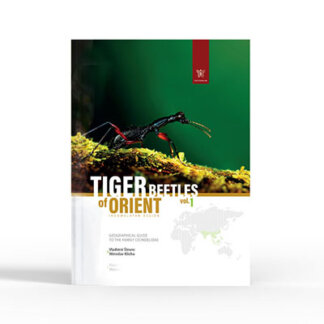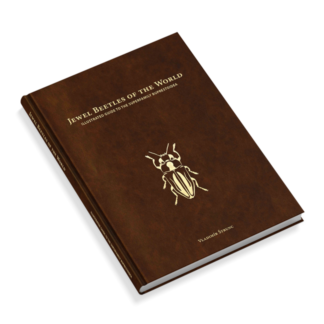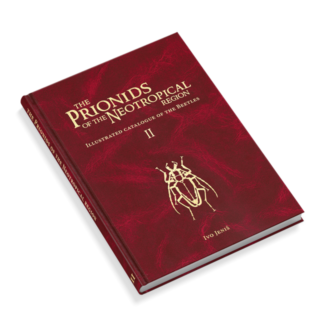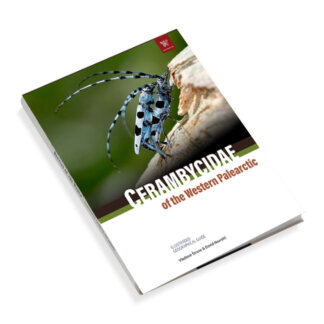Coleoptera, commonly known as beetles, is the largest order of insects and one of the most diverse groups of animals on Earth. This order includes over 400,000 described species, representing approximately 40% of all known insect species and 25% of all animal species. Estimates suggest the actual number of beetle species may range from 0.9 to 2.1 million.
Book novelties:
Prioninae of the World I.
Cerambycidae of the Western Paleartic I.
Coleoptera
We recommend:
jeweled beetles, ground beetles, longhorn beetles, goliath beetle, stag beetle, carpet beetles
Coleoptera: Overview
Books about Beetles
Unique pictorial atlases for identifying Beetles:
(2020) Tiger Beetles of the World, Cicindelidae, Illustrated guide to the genera
(2023) Tiger Beetles of Africa, Cicindelidae, Geographical guide to the family Cicindelidae
(2024) Tiger Beetles of Orient, Cicindelidae, Geographical guide to the family Cicindelidae
(2022) Ground Beetles of Africa, Afrotropical Region
(2022) Jewel Beetles of the World, Buprestidae, Illustrated guide to the Superfamily Buprestoidea
(2008) The Prionids of the World, Prioninae, Illustrated catalogue of the Beetles
(2010) The Prionids of the Neotropical region, Prioninae, Illustrated catalogue of the Beetles
Key Characteristics Coleoptera
Elytra: Beetles are distinguished by their hardened front wings (elytra), which protect their membranous hind wings and abdomen.
Body Structure: They exhibit a wide variety of body shapes and sizes, ranging from less than a millimeter to over 20 centimeters in length. Their antennae are always segmented and vary greatly in form.
Mouthparts: Chewing mouthparts are adapted for diverse diets, including plant material, fungi, and other insects.
Metamorphosis: Beetles undergo complete metamorphosis, transitioning through egg, larva, pupa, and adult stages.
Habitat and Distribution
Beetles inhabit nearly every environment except marine ecosystems and polar regions. They are found in deserts, forests, freshwater systems, and even underground or in association with other organisms like ants and termites.
Ecological Roles
Decomposers: Many beetles break down organic matter such as plant debris or animal carcasses.
Predators: Species like ladybugs feed on pests such as aphids.
Pollinators: Some beetles contribute to pollination.
Pests: Certain species, such as the Colorado potato beetle, are agricultural pests.
Diversity Coleoptera
Coleoptera is divided into four suborders:
Archostemata
Adephaga
Myxophaga
Polyphaga
(the largest suborder containing most beetle families).
Interesting Adaptations
Bioluminescence: Fireflies (family Lampyridae) produce light for communication and mating.
Aquatic Adaptations: Several families like Hydrophilidae are adapted to aquatic environments.
Sound Production: Some beetles can produce sounds by stridulation (rubbing body parts together).
Economic Importance
Beetles have significant impacts on agriculture and forestry:
Beneficial species control pests.
Harmful species damage crops or stored products. Coleoptera.
In summary, Coleoptera is an incredibly diverse order with critical ecological roles and fascinating adaptations. Their widespread presence across habitats underscores their evolutionary success.
-
 Tiger Beetles of Orient€ 129.00
Tiger Beetles of Orient€ 129.00 -
 Tiger Beetles of Africa€ 129.00
Tiger Beetles of Africa€ 129.00 -
 The Prionids of the WorldProduct on sale€ 59.00
The Prionids of the WorldProduct on sale€ 59.00 -
 Ground Beetles of Africa (2nd edition)€ 136.00
Ground Beetles of Africa (2nd edition)€ 136.00 -
 Jewel Beetles of the World€ 105.00
Jewel Beetles of the World€ 105.00 -
 Tiger Beetles of the World€ 109.00
Tiger Beetles of the World€ 109.00 -
 The Prionids of the Neotropical regionProduct on sale€ 59.00
The Prionids of the Neotropical regionProduct on sale€ 59.00



